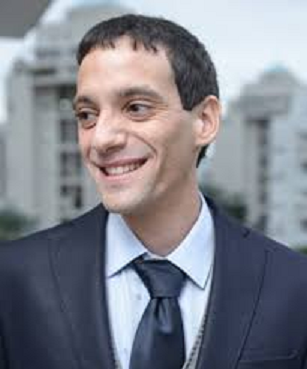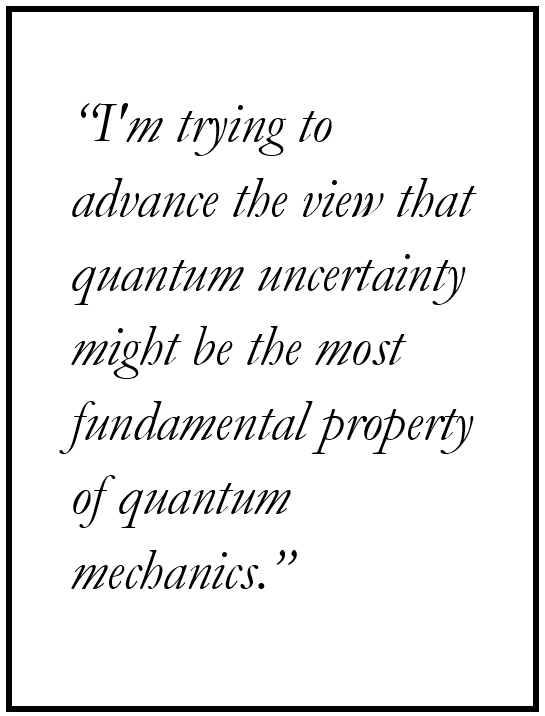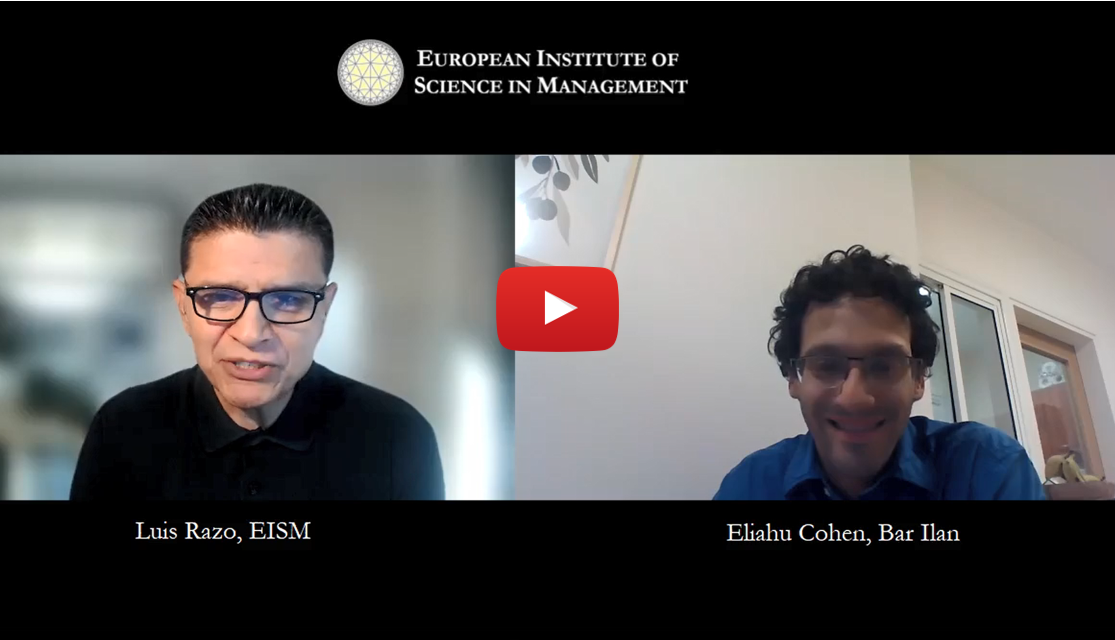
Dr. Eliahu Cohen is a pioneering theoretical physicist and quantum engineer. He is currently a senior lecturer at the Alexander Kofkin Faculty of Engineering at Bar Ilan University in Israel. He is also a member of the “Institute for Nanotechnology and Advanced Materials” and the “Center for Quantum Entanglement Science & Technology” at the same university. In addition, he is the head of the new Quantum Engineering BSc Program, where he teaches Quantum Computation, Applied Quantum Mechanics, and Applied Thermodynamics.
In today’s discussion, Prof. Cohen talks to Luis Razo Bravo, executive director of EISM, as part of EISM’s “Leadership Series” of talks. Among the discussion topics are Prof. Cohen’s theoretical and practical interests in various quantum technologies and Prof. Cohen’s many years of collaboration with the eminent theoretical physicist, Yakir Aharanov. Cohen and Razo also discuss how Aharanov’s “two-state vector formalism” continues to inspire Cohen’s research, and about some of the controversies related to the idea that a backward-evolving wave function can be a useful approach to thinking about the deepest puzzles at the foundations of physics.
* The following text has been excerpted from the full interview, which may be viewed below.

1. Can you tell us about your academic interests in general?
Sure, I think your introduction was pretty accurate because my research group is called “From quantum foundations to quantum technology” and it reflects my own trajectory in science, starting, as you said, from a masters and then a PhD with Yakir Aharanov and Lev Vaidman, but also the situation in quantum mechanics in which many open questions still seem to require attention but at the same time we constantly see new technologies and a new practical applications so quantum theory is highly successful both on the theoretical and practical side but nevertheless there are fundamental issues to be solved, and my group currently with about 15 members is trying to tackle both areas. On the fundamental side, we are still interested very much in the study of time, mainly using quantum clocks and also of course the two-state vector formalism. And we still study non-locality and mainly entanglement, and other forms of stronger than classical correlations. Indeed, we are interested in better understanding the process of measurement and the apparent collapse that we see in experiments, as well as the classical/quantum boundary. We also have some projects on naive approaches to quantum gravity, mainly from a quantum information perspective. On the practical side, we work on quantum imaging, quantum sensing, mostly quantum radar-like sensors, and in quantum communication, we work on the security of quantum key distribution protocols, as well as counter factual communication — that is, communication without the photons in the transmission channel, at least to some probability. And we also work on quantum computation, devising some new applications of quantum walks and trying to better understand the source of quantum speed up from a foundational point of view. I think these are the main interests.
How did you come across the two-state vector formalism and Yakir Aharanov?
Yeah, I think I was very lucky as a student at Tel Aviv University to hear a talk by Yakir Aharanov. I knew the name but I didn’t know exactly what he works on and one day we received an invitation to hear him talking about the two-state vector formalism and this was mind-boggling, really. I knew quantum mechanics but not the way that he told it, and I was utterly intrigued. When I looked for a master supervisor slightly afterwards, I could think of nobody else I would like more to supervise me and although I was a bit hesitant to approach him, [another person] also helped me to meet him. And then we started working together from the first meeting. We immediately starting writing some joint paper and we are still working together. He celebrated recently his 90th birthday. He’s very sharp and very fruitful. He has amazing ideas all the time, so yeah it has been a real pleasure to work with him.

Richard Feynman talks about the importance of interpretation in physics. Can you talk about the role of interpretation in your work?
Yes, sure. In our work we sometimes use the ordinary Copenhagen interpretation but sometimes we use the Bohmian interpretation, uh, Bohm-Debroglie pilot wave, we use the hydrodynamic modeling approach, and in one work with Vaidman we also thought about it in terms of the many-worlds interpretation. So I really agree with this [Feynman’s approach to interpretation], bearing in mind that interpretation should explain what we see, but it should give, as predictions, all of the things, all the observations that that we have, and it cannot deviate from them. Nevertheless, the two-state vector formalism has been very helpful for conceiving new ideas.
Can you talk about some of these new ideas and maybe the empirical advantages of taking a two-state approach?
Sure, I can give you several examples. Weak measurements that we discussed were born inside or within the two-state vector formalism, and can even be thought of as a tool or as an offshoot of the formalism. But by now weak measurements are very interesting and helpful in their own right. They are not only a tool, they are a subject of research in themselves, and with many experimental demonstrations employing weak measurements in order to enhance the precision in quantum sensing, and so weak measurements were inspired and gained a lot of understanding from the two-state vector formalism. This is one example.
Another example which is somewhat related is the phenomenon of superoscillations and superoscillations described as such by Professor Sir Michael Berry, and relied on some idea that was developed in Tel Aviv, according to which when you prepare an infra-red photon in a box having several possible frequencies and you can get upon a particular post-selection and ultraviolet photon outside the box and so super oscillations describe a surprising scenario where a function oscillates faster than its fastest fourier component, and at least in some small region of space and time, so this is another example of major interest nowadays.
A third example is quantum walks, which were also conceived using the intuition from weak measurements and the two-state vector formalism and many many quantum paradoxes showing us just how quantum mechanics is intriguing and different from classical mechanic, and I think that that it’s very constructive that many of these proposals have already been realized in the lab. They were demonstrated in photonic systems, but also with atoms and neutrons, and with superconducting qubits, and with trapped ions there were many physical platforms which realized these theoretical ideas stemming from the two-state vector formalism.

What do you think are some of the most interesting prospects for the future of physics research?
Yes, this is a big question. First, I strongly believe in the employment of mathematical tools of quantitative analysis and but together with this toolkit, Aharanov always emphasized the importance of having a good question a good physical question and a good physical intuition towards this question, before even doing the math. I think this may apply to other fields of research and science, even social sciences.
During the last few years I’m trying to advance the view according to which quantum uncertainty might be the most fundamental property of quantum mechanics. Any phenomenon that I see, any quantum phenomena, can be traced back to quantum uncertainty or to non-commutativity of observables. And I see uncertainty as an enabler, which gives us freedom to succeed in in various tasks, for instance quantum key distribution that I mentioned relies on quantum uncertainty for being secure.
And also when we analyze quantum algorithms, when we analyze quantum computation, we see that the non-commutativity which is the quantum property, the fact that once you do one act it cannot be replaced with another coming afterwards without changing the result…so uncertainty is both a fundamental property but also a vital resource that we are trying to work with.
Another example related to what we are doing and in quantum light, and also with matter, there’s the notion of squeezing where we try to squeeze the uncertainty in one parameter by playing with increasing the uncertainty in another parameter. And so all these manipulations with uncertainty might also apply to some extent when we think about classical uncertainty. I tend to think that classical uncertainty is also a fundamental factor to take into account. We need to try to know what we don’t know. And, of course, there are others things we don’t know that we don’t know, but all of these affect what happens so it’s better to control them in the best way we can and adapt to this uncertainty.
And finally there’s the final boundary condition, which philosophically tells us that we needn’t forget about what’s coming next or we don’t necessarily – we can’t rely solely on the past – we have some “destiny”, in the language of quantum mechanics, waiting for us. So it’s not a scientific explanation, it’s just a uh wishful thinking to keep in mind and to think more about the future and not only about the past.


